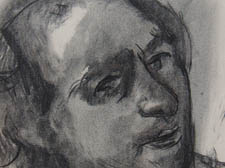|
|
 |
| |

Self Portrait (charcoal, 1931), |
Emerging from the muddy pool
David Bomberg is now considered to be one of Britain’s finest pioneering painters – and certainly not a ‘phoney’, as a former student explains to Gerald Isaaman
MILES Richmond was adamant he was right about the charismatic teacher when he wandered into an art class – albeit after persuasion – at what was then the Borough Polytechnic in South London, and sat down to listen to David Bomberg.
And his opinion? “He’s a phoney.”
The year was 1946. “I had already been to art school and didn’t want any more art training, so I went very unwillingly,” he recalls. “My first impression was that he was a charlatan whose attitude to art and to his profession was in another world.
“I had been used to art teachers who talked about making pictures that fitted into an accepted established order. Bomberg was extremely radical. He wanted to kick all that over. He rejected everything and was even deeply sceptical about Picasso.
“I remember going back home and saying to myself ‘Well, I’ll paint a picture that sums up what that old fool’s got to say’. I painted it. Now I am ashamed to recall that instance because I hadn’t begun to understand the immensity of what Bomberg was about.”
Indeed, the art world also brutally rejected the then early geometric abstract art of David Bomberg. The Birmingham-born son of a Jewish leather worker from Poland grew up poor in London’s Whitechapel. He became a lithographer before attending evening classes given by the English Impressionist Walter Sickert.
Now, 50 years after his death, Bomberg’s neglected art is being triumphed at a vital retrospective exhibition at the Boundary Gallery, Swiss Cottage. Miles Richmond, now 84, will be there to talk about the charlatan he came to work for and admire as a real visionary during Bomberg’s days teaching in southern Spain.
Bomberg’s life, which included a short spell living in Lyndhurst Road, Hampstead, is a remarkable tale of a man who explored the very nature of art, ignoring any kind of recognition or fortune.
“He sacrificed his own reputation by devoting so much energy to teaching,” Richmond told me. “His professional colleagues laughed at him for putting so much effort into campaigning for his ideas and the fact that he exhibited alongside his students – like me. That made him ridiculous in their eyes.
“If he were alive now he would see his rising reputation as the natural consequence of life. I mean, if you have a muddy pond all stirred up, you gradually let it settle and then some things will go to the bottom and some things will keep floating to the top. Bomberg’s view was that sooner or latter his real worth would float to the surface.”
The exhibition will include examples of Bomberg’s Futurist and Impressionist art through his career.
The works cover the days of the Borough Group (1947-50), of which Richmond was a leading member. There are portraits of his step-daughter, Dinora, and her artist husband Leslie Marr, painted in 1951 and 1952, which have never been exhibited together before.
It was a friend of Dinora who suggested that Richmond attend Bomberg’s lessons at the Poly – now part of the London South Bank University – not knowing that Bomberg had long ago made his mark and in his early days had met Picasso, Modigliani, Derain and Epstein.
Richmond can’t recall the crucial moment when his deep scepticism of Bomberg faltered. “He was so deeply serious. I couldn’t resist his obvious seriousness,” he says. “He was essentially a modest man but one who believed so passionately in his own ideas.
“Painting to him was a kind of fundamental research into the way the world works – the nature of matter; the relation between mind and matter. These were the things that concerned Bomberg, not making a success as a painter.”
It was while living in Aix-en-Provence, home of Paul Cézanne, in the 1950s, that Richmond and his wife Suzanne met up again with former Bomberg students Dorothy Mead and Cliff Holden. They went to live and work with them in an old factory in Torrox, in Spain.
They heard that Bomberg had himself returned to the mountains of Ronda, not far from Malaga, to set up an art school haven for the avant garde. “He was our teacher – and I decided to go up to see him,” Richmond remembers.
At Bomberg’s invitation he became the painter’s assistant. He was to stay on in Ronda beyond the summer day in 1957 when he took the depressed, over-worked and seriously sick Bomberg to hospital in Gibraltar. He never saw him again before he died later that year, aged 66, in St Thomas’ Hospital, in London, on August 19.
Richmond, now dedicated to his magnificent mentor, declares:
“Bomberg told me he had never seen the sun until he went first to Palestine – he thought England was pretty dark – and then to Spain. And from then on the sun was crucially important to him.
“His radical work is that he studied the relationship between matter and light. And he studied it with great intensity because he knew that was the area Einstein was studying.
“And some say that if Bomberg hadn’t been a painter he would have been a mathematician. It is 50 years since he died. And every year that passes his stature and reputation increases. He certainly wasn’t the phoney I first thought he was.”
|
 |
|
| |
|
 |
|

